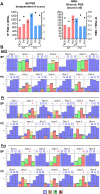Insight into the epigenetic regulation of gene expression in the bloodstream and procyclic forms of Trypanosoma brucei through the involvement of G-quadruplexes
- PMID: 40677914
- PMCID: PMC12267983
- DOI: 10.1093/nargab/lqaf100
Insight into the epigenetic regulation of gene expression in the bloodstream and procyclic forms of Trypanosoma brucei through the involvement of G-quadruplexes
Abstract
This study explores how G-quadruplexes (G4s) influence gene expression during the transition between bloodstream (BF) and procyclic (PC) forms of Trypanosoma brucei brucei. Computational analysis identified over 115 000 G4-prone sequences, with 63% predicted to form stable G4 structures. These sequences are enriched in regions associated with antigenic variation, suggesting a role in gene regulation. Experimental validation using G4 ligands (AQ1, Pt-TTPY, and pyridostatin) showed a consistent downregulation of differentially expressed genes, supporting the potential relevance of targeting G4s. These results contribute to our understanding of epigenetic regulation in T. brucei and may help inform future approaches for managing parasitic infections.
© The Author(s) 2025. Published by Oxford University Press on behalf of NAR Genomics and Bioinformatics.
Conflict of interest statement
None declared.
Figures






Similar articles
-
G-quadruplex structures regulate long-range transcriptional reprogramming to promote drug resistance in ovarian cancer cells.Genome Biol. 2025 Jul 12;26(1):183. doi: 10.1186/s13059-025-03654-y. Genome Biol. 2025. PMID: 40646632 Free PMC article.
-
Chemical and Genetic Validation of an Essential Calcium Entry Channel of Trypanosoma brucei as a Therapeutic Target.ACS Infect Dis. 2025 Jun 13;11(6):1741-1752. doi: 10.1021/acsinfecdis.5c00329. Epub 2025 Jun 3. ACS Infect Dis. 2025. PMID: 40462260 Free PMC article.
-
In-depth analysis of the mode of action of resveratrol: genome-wide characterization of G-quadruplex binding properties.Cell Mol Biol Lett. 2025 Jun 20;30(1):74. doi: 10.1186/s11658-025-00747-1. Cell Mol Biol Lett. 2025. PMID: 40542407 Free PMC article.
-
The Lived Experience of Autistic Adults in Employment: A Systematic Search and Synthesis.Autism Adulthood. 2024 Dec 2;6(4):495-509. doi: 10.1089/aut.2022.0114. eCollection 2024 Dec. Autism Adulthood. 2024. PMID: 40018061 Review.
-
G4-interacting ligands: paving the way for precision medicine and molecular diagnostics.J Biomol Struct Dyn. 2025 Jul;43(10):5068-5073. doi: 10.1080/07391102.2024.2306498. Epub 2024 Jan 24. J Biomol Struct Dyn. 2025. PMID: 38263926 Review.
References
MeSH terms
LinkOut - more resources
Full Text Sources
Miscellaneous

